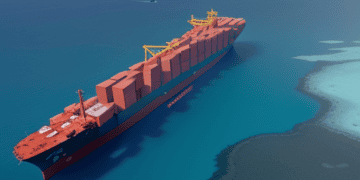In recent developments within the global shipping sector, Maersk, a leading figure in maritime logistics, has alerted stakeholders about the potential for continued disturbances affecting container shipments through the pivotal Red Sea corridor. These disruptions, projected to persist into the latter half of the year, stem from increased congestion and subsequent delays for merchandise en route to the United States. The shift in shipping paths, diverting from the traditional Red Sea and Suez Canal routes due to security concerns raised by Houthi militant activities, has prompted this advisory.
Charles van der Steene, Maersk’s North American division head, underscored the importance for companies to recalibrate their expectations, advocating for the integration of extended transit times into their supply chain forecasting. This situation, as reported by Reuters, necessitates a strategic rethink for businesses aiming to maintain efficiency amidst the evolving logistical landscape.
In an effort to alleviate some of the strain caused by these reroutings, Maersk has proactively augmented its vessel capacity by approximately 6%, a move designed to cushion the blow from increased journey lengths, notably around Africa’s Cape of Good Hope. This adjustment reflects a broader industry trend, with key players seeking to adapt to the dynamic challenges impacting global commerce.
The implications of these prolonged transit periods are multifaceted, affecting not only scheduling but also financial planning for corporations. With freight rates on the rise due to lengthier sailing times, companies such as Walmart and Nike face a reevaluation of their logistical expenses. This shift in cost dynamics, as highlighted by van der Steene, necessitates a reexamination of budgetary allocations, where a change in per-unit costs could significantly influence overall financial strategies.
Furthermore, the extended navigation around Africa has introduced notable delays for vessels targeting the US East Coast, prompting Maersk to recommend alternative port destinations within Mexico, the Pacific Northwest, and Los Angeles to circumvent these bottlenecks. This advice forms part of a broader strategy aimed at maintaining fluidity in supply chains, as the industry grapples with additional challenges, including severe congestion at Oakland, California. This particular bottleneck exacerbates the delay cycle, impacting the turnaround time for containers heading back to Asia.
As the ripple effects of these disruptions reverberate throughout the supply chain, the necessity for innovative logistical solutions has never been more apparent. The current scenario underscores the critical role of adaptability and strategic foresight in navigating the complex and interconnected landscape of global trade. For industry watchers and participants alike, the situation in the Red Sea serves as a poignant reminder of the vulnerabilities and opportunities that lie within the fabric of international commerce.
Find the best supply chain logistics news at The Supply Chain Report. Free international trade tools are available at ADAMftd.com.
#Maersk #GlobalShipping #RedSea #SupplyChain #LogisticsChallenges #ContainerShipments #MaritimeLogistics #TransitDelays #ShippingRoutes #HouthiConcerns #FreightRates #InnovativeLogistics #SupplyChainManagement #TradeAdaptability #EconomicImpact #PortDestinations #LogisticsSolutions #GlobalTrade #SuezCanal #ShippingIndustry

















